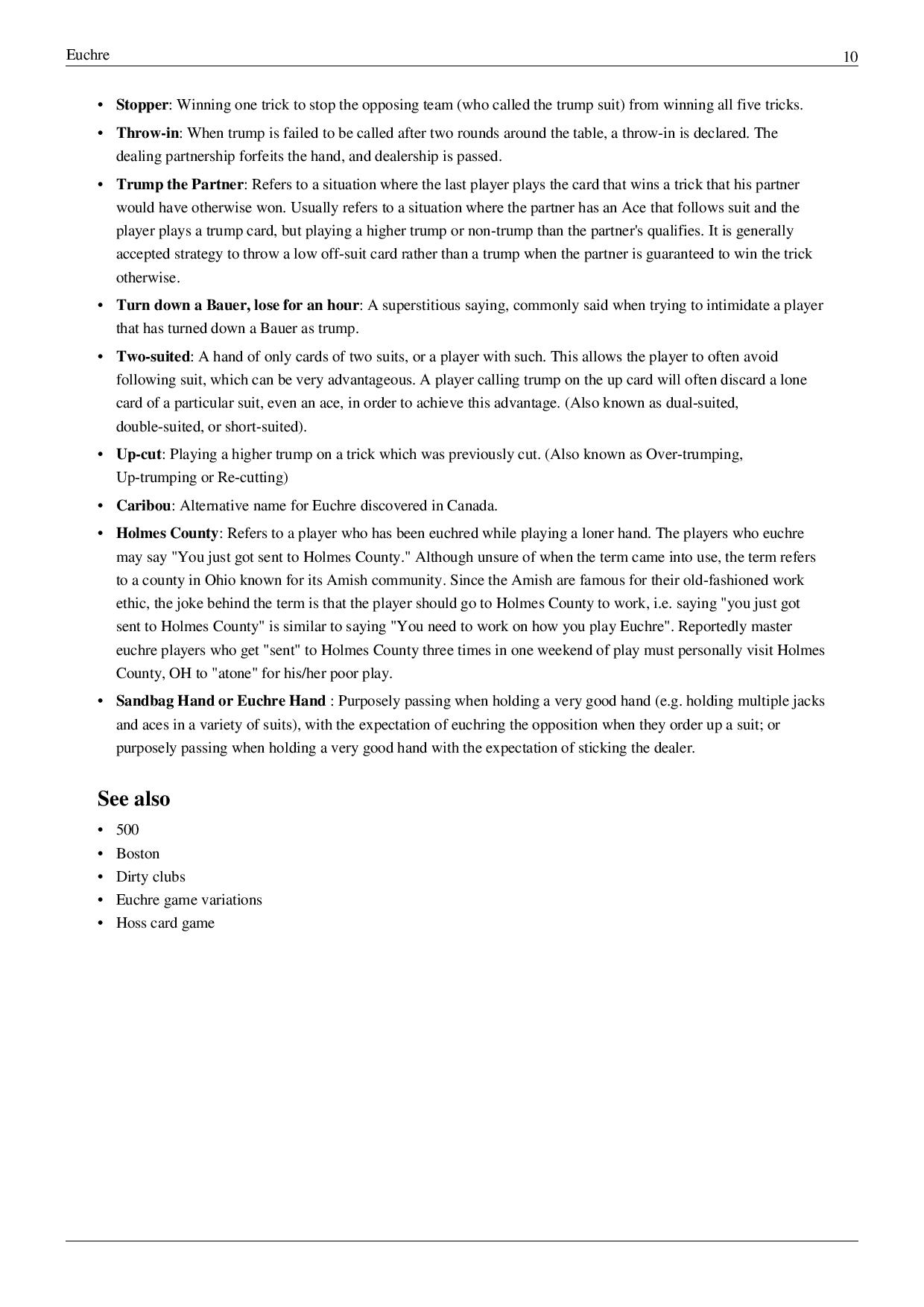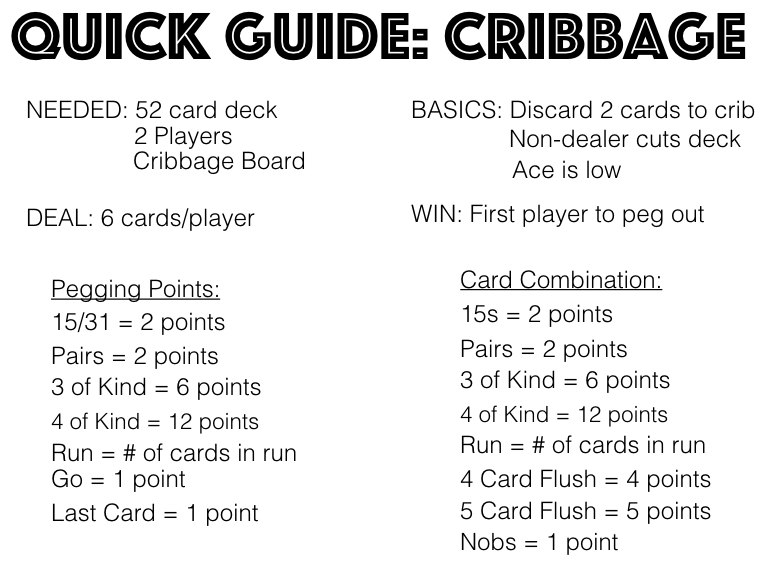Basic Rules Of Cribbage
- Cribbage Game Rules - How To Play Cribbage The Card Game
- Printable Basic Rules Of Cribbage
- Basic Rules Of Euchre
- Cribbage: Rules - LearnPlayWin

OBJECTIVE OF CRIBBAGE: Be the first player to score 121 points (or 61 points).
Nov 28, 2012 Cribbage is traditionally played with two people, but you can also play with four (two on two) or with three with modified rules. It can also be played with either five or six cards, but the latter is by far the most common and popular version. Rule variations for three- and four-player cribbage are given after the basic rules. Equipment needed A cribbage board and a standard deck of 52 cards (jokers discarded). See full list on wikihow.com.
NUMBER OF PLAYERS: 2-3 players
NUMBER OF CARDS: standard 52-card
RANK OF CARDS: K (high), Q, J, 10, 9, 8, 7, 6, 5, 4, 3, 2, A
MATERIALS: Cribbage board

TYPE OF GAME: Other
AUDIENCE: 10+
INTRODUCTION TO CRIBBAGE
Cribbage is a 400-year-old game that descended from an English card game known as “Noddy.” The creator of the game was Sir John Suckling, who was an English poet. The most interesting facet of cribbage is its use of a cribbage board to keep score, rather than a pen and paper. This also makes scoring more efficient which in turns makes the game more fast-paced and engaging.

This game is tailored for 2 or 3 players, however, players can form teams of two in a four player game.
The goal of the game is to accumulate points to the target 121 points (or 61 points). Points are earned by making card combinations.
THE CRIBBAGE BOARD
A Cribbage Boards has 4 rows with 30 holes in each row. The rows are split into two sets of rows by a middle panel. Each player receives a total of 121 continuous holes on some boards. The board is kept between the players. Each player grabs two pegs that are the same color. Every time a player scores, they move a peg along their side of the board. 1 hole = 1 point. Pegs jump each other to demonstrate the increment of the points gained between turns. A game of 61 points is referred to as a “once around” and a game of 121 points as a “twice around.”
THE DEAL
Using a shuffled deck, each player cuts a single card, leaving a minimum if four cards at the end of the deck. If two players draw cards of equal rank they must draw again. The player who has the lowest cut card deals first. The deal alternates after the first hand. However, when starting a new game the loser of the previous one is the first dealer. The dealer shuffles the cards last and lets a non-dealer cut the deck before dealing.
After, the dealer passes each player 6 cards face-down, starting with their opponent or the player to their left.
THE CRIB
Players examine their 6 card hand and must “lay away” two cards for a total of four cards in hand. Those four cards laid away are “the crib.” The crib is the dealer’s, however, these cards are not revealed until after the hands are played.
PRE-PLAY
Once the rib is “laid away,” a non-dealer player cuts the deck. The top card of the lower part of the deck is placed on top. This is the starter card. If this card is a jack, it is referred to as “His Heels,” dealer pegs 2 (scores 2) points. This card is not used in Cribbage play but is used rather later when players make card combinations.
THE PLAY
After the starter was flipped, the nondealer plays a single card on the table, face-up. Then the dealer follows, revealing a card. This continues back and forth, their hands being exposed one card at a time. Players keep the cards in their hands separate.
Each player must announce the running total of the value of cards by adding the one they are playing to the one previously played. For example, play beings with a 2, the nondealer says, “two.” Next, the dealer plays an 8, they say “ten.” Kings, Queens, and Jacks are all worth 10 points. Number cards are worth face value or pip value.
THE GO
The cards running total cannot exceed 31. Once a player cannot play a card without going over 31, they must say “go.” Their opponent then pegs 1. After the Go, the opponent can play any cards in hand that can be played without making the total exceed 31. They can also score points for pairs and runs, which are described below. If a player hits 31 exactly, they peg 2. Whoever called Go leads in the next phase of play, the count begins at zero again. You cannot lead the next phase with cards previously used to score combinations. Whoever plays the last card gets to peg 1 for Go and an extra peg if they land directly on 31.
PEGGING
The goal of the game is to collect points through pegging. Players can score points for a Go and the following combinations:
Fifteen: Playing a card that makes the total = 15, Peg 2
Pair: Playing a card of equal rank as the one previously played, Peg 2
Four (Double Pair, Double Pair Royal): Adding the 4th card of same value, Peg 12
Run (Sequence): Adding cards, that with cards previously played, form:

- Sequence of 3, Peg 3
- Sequence of 4, Peg 4
- Sequence of 5, Peg 5
- Each next card in a sequence, Peg 1 each
Be careful to keep cards in the order which they were played.
Cribbage Game Rules - How To Play Cribbage The Card Game
THE HANDS
Once play finishes, the three hands are counted in this order: non-dealer, dealer, crib. Non-dealers can “count out” near the end of the game and win before the dealer has the opportunity to count their hand. The starter applies to each hand so they both total 5 cards. They are counted as follows:
Fifteen: Each set of cards that total 15, 2 points each
Pair: Two cards of equal rank, 2 points each
Run: Sequence of 3+ cards, 1 point per card
Flush: 4 cards of the same suit (not including the crib or the starter), 4 points
4 cards in hand or in the crib that are the same suit as the starter, 5 points
His Nobs: Jack of the same suit as the starter either in hand or in the crib, 1 point each
Printable Basic Rules Of Cribbage
END GAME
Cribbage can be set at either 121 points or 61 points and the game ends once a player reaches the target points. If the non-dealer goes out first the dealer does not get to score their hand and the game ends. If one player goes out before the other reaches half the target score, the loser is said to be “lurched,” and the winner scores for 2 games rather than just 1. Some variations play “skunk” or double game, which means if the loser fails to meet 3/4 the target point the winner wins a double game. And, if the player doesn’t reach the half of the target score, it’s a “double skunk” or quadruple game.
Basic Rules Of Euchre
REFERENCES:
Cribbage: Rules - LearnPlayWin
http://www.cribbage.org/rules/rule1.asp
https://en.wikipedia.org/wiki/Rules_of_cribbage